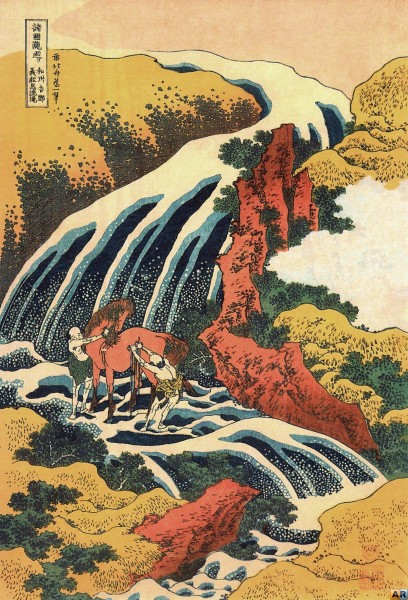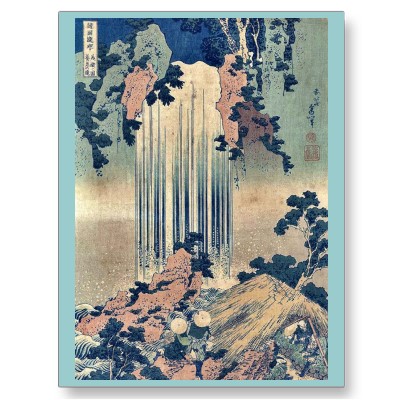 Here are some photographs of Japanese gardens, recently sent to me (by Shawn Tribe my colleague at the New Liturgical Movement). I do not remember what we were discussing (no doubt something seriously liturgical!) when as a complete non-sequitur he started sending a string of photos to me with a 'How do you like these?'. He said he had just found them and thought they were beautiful and that was his only justification for sending them.
I do not know anything about the Japanese philosophy of gardening and so haven't got much to offer beyond the photos themselves - I post these for sheer enjoyment. Looking at them though, there is so much more to these than the Zen raked-gravel-with-single-profound-boulder garden (typical of many of the 'Japanese' recreations in Western museums that I have seen). My uninformed speculation is that they reflect a desire to create idealised rural landscapes - a sense of what nature ought to be. In this respect not dissimilar to the 18th century English landscaped gardens of designers such as Capability Brown.
Here are some photographs of Japanese gardens, recently sent to me (by Shawn Tribe my colleague at the New Liturgical Movement). I do not remember what we were discussing (no doubt something seriously liturgical!) when as a complete non-sequitur he started sending a string of photos to me with a 'How do you like these?'. He said he had just found them and thought they were beautiful and that was his only justification for sending them.
I do not know anything about the Japanese philosophy of gardening and so haven't got much to offer beyond the photos themselves - I post these for sheer enjoyment. Looking at them though, there is so much more to these than the Zen raked-gravel-with-single-profound-boulder garden (typical of many of the 'Japanese' recreations in Western museums that I have seen). My uninformed speculation is that they reflect a desire to create idealised rural landscapes - a sense of what nature ought to be. In this respect not dissimilar to the 18th century English landscaped gardens of designers such as Capability Brown.
The following passage is taken from a website produced by Columbia University, here. If it is a fair overview, then it what it describes is consistent with the Christian belief that the untamed wilderness is not the perfect standard of beauty (which is what so many modern Westerners seem to believe). Rather, that man, through God's grace (for the Christian) can improve the wilderness and mould it into something closer to what it ought to be. Buildings, therefore, are not to be thought of as unnatural aberrations but (provided they are built well) as another aspect of properly ordered nature.
The Japanese garden embodies native values, their cultural beliefs and religious principles. This is why there is no one prototype for the Japanese garden, just as there is no one native philosophy or aesthetic. In this way, similar to other forms of Japanese art, landscape design is constantly evolving because of the influx of mainland, namely Chinese, influences as well as the changing aesthetic tastes and values of the patrons.
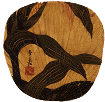 |
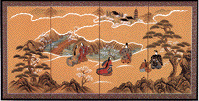 |
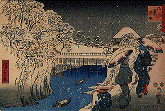 |
| Edo Period |
Heian Period |
Ukiyo- e |
The line between garden and its surrounding landscape is not distinct. The two embody each other in that every aspect of the landscape is in itself a garden. Also, when observing the garden, the visitor should not distinguish the garden from its architecture. Gardens incorporate natural and artificial elements and thus, fuse the elements of nature and architecture.
In order to appreciate and understand the Japanese garden, the viewer should consider nature as a picture frame into which the garden, or the man- made work of art, is inserted. It is in this way the garden also helps the visitor understand his surroundings.
I do not know the location of every picture. I give details for those that I do.

Himeji-jo Castle, Himeji, Kinki
 Garden Staircase, Kyoto, Japan
Garden Staircase, Kyoto, Japan



 Kinkakuji Temple, Kyoto, Japan
Kinkakuji Temple, Kyoto, Japan

Ninnaji Temple, Kyoto

And, having been so rude about Western attempts to recreate Japanese gardens, here is one that proves me wrong! It is at the University of British Columbia.
Perhaps the maples shown in the last photo are not Japanese but Canadian. It reminds me of a story from when I was eleven. We had a beautiful ornamental Japanese maple in our garden at home. I used to ask my dad about it so often that as a joke he taught me the Latin name for it - acer palmatum dissectum atropurpureum. I can remember him laughing when I parroted the phrase back at him. About a week later I was in the garden of a family friend who by coincidence was watering a red-leafed Japanese maple that looked just like the one at home. 'Ah,' I said solemnly. 'I see you have an acer palmatum dissectum atropurpureum.' He looked at me in astonishment. What an insufferable little boy I must have been. (And before anyone says it, still am no doubt!)
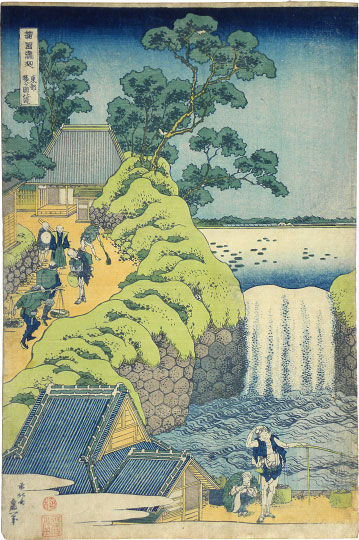 Here is a series of 18th century prints by the Japanese artist called Katsushika Hokusai(1760-1849). I saw them recently as a new display at the permanent collection of the Worcester Art Museum in Worcester, Massachusetts. Chinese and Japanese landscape is worthy of study even by those interested in painting landscape in the Western tradition. The composition is consistent with the Christian view that nature is beautiful and hierarchical and points to something greater beyond itself, with man at the pinnacle of the natural world, whether he is a subject within the painting, or the observer seeing nature through the eyes of the artist.
This is a series of prints called A Tour of Waterfalls in the Provinces made in 1833. This is a new display at the Worcester Art Museum and it has been very nicely handled, so that the series appears as a body of work, with each print angled upwards so that it is easily visible and reducing glare of the protective glass.
Here is a series of 18th century prints by the Japanese artist called Katsushika Hokusai(1760-1849). I saw them recently as a new display at the permanent collection of the Worcester Art Museum in Worcester, Massachusetts. Chinese and Japanese landscape is worthy of study even by those interested in painting landscape in the Western tradition. The composition is consistent with the Christian view that nature is beautiful and hierarchical and points to something greater beyond itself, with man at the pinnacle of the natural world, whether he is a subject within the painting, or the observer seeing nature through the eyes of the artist.
This is a series of prints called A Tour of Waterfalls in the Provinces made in 1833. This is a new display at the Worcester Art Museum and it has been very nicely handled, so that the series appears as a body of work, with each print angled upwards so that it is easily visible and reducing glare of the protective glass.






